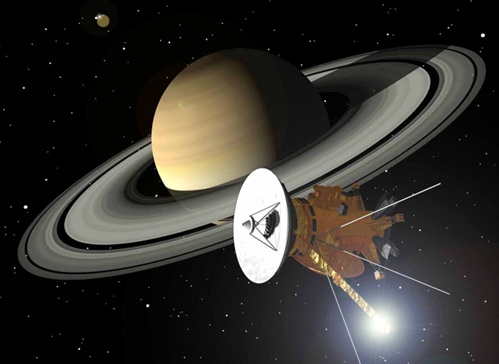(Prelims: Current Events of International Importance, General Science)
(Mains, General Studies Paper 3: Science and Technology – Developments and Applications and Their Impact on Everyday Life, Information Technology, Space, Computers) |
A new study using data collected by NASA's Cassini spacecraft has provided additional evidence that life may be possible on Saturn's moon Enceladus.

About the Cassini Spacecraft
- It is a joint project of NASA, the European Space Agency, and the Italian Space Agency (ASI).
- Cassini was a sophisticated robotic spacecraft designed to conduct a unique and detailed study of Saturn and its complex system of rings and moons.
- It was launched on October 15, 1997. It was one of the largest interplanetary spacecraft.
- This mission included NASA's Cassini orbiter, the first spacecraft to orbit Saturn, and ESA's Huygens spacecraft, which landed on Saturn's largest moon, Titan.
Objectives of the Cassini spacecraft
- Saturn: Study of cloud properties and atmospheric composition, wind and temperature, internal structure and rotation, ionosphere, origin and evolution
- Rings: Study of their structure and composition, dynamic processes, interactions between rings and satellites, dust and micrometeoroid atmosphere
- Titan: Study of atmospheric constituent abundances, distribution of trace gases and aerosols, wind and temperature, surface composition and state, and upper atmosphere
- Saturn's magnetic field: Study of its structure and electric currents; composition, sources, and sinks of particles within it; dynamics; interaction with solar wind, satellites, and rings; Studying Titan's interaction with the solar wind and magnetic field
Components of the Cassini spacecraft
- Instruments on Cassini included radar to map Titan's cloud-covered surface and a magnetometer to study Saturn's magnetic field.
- The disk-shaped Huygens probe was mounted on Cassini's side and carried six instruments designed to study Titan's atmosphere and surface.
- Key facts about Enceladus
- It is named after a giant planet from ancient Greek mythology. It is one of the innermost moons of the ringed gas giant Saturn.
- It has a diameter of 313 miles (504 km) and orbits Saturn at a distance of approximately 148,000 miles (238,000 km).
- Scientists believe that Enceladus possesses the chemical elements necessary for life and that its hydrothermal vents release warm, mineral-rich water into its ocean, similar to the environment that may have given rise to Earth's first living organisms.
- Its ocean lies beneath a layer of ice approximately 12–19 miles (20–30 km) thick.



